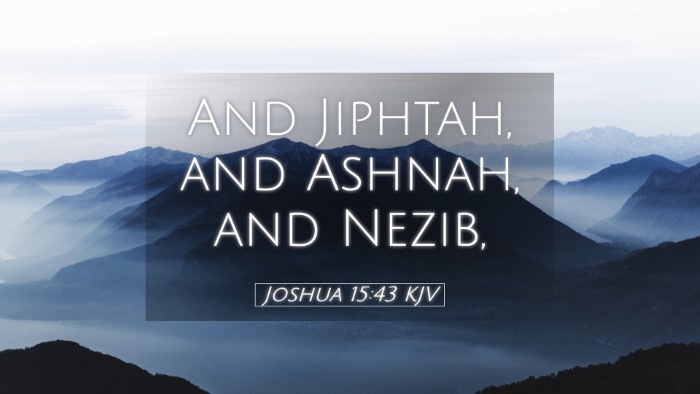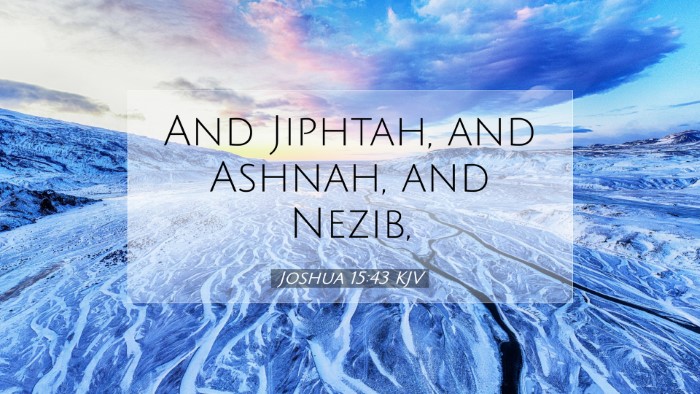Commentary on Joshua 15:43
Verse: "And in the plain, Eshtaol, and Zoreah, and Ashnah."
Contextual Overview
This verse is a part of the account of the allotment of the Promised Land to the tribes of Israel, specifically focusing on Judah's inheritance. The passage highlights the cities located in a specific region, reflecting the intentional delineation of territory among the tribes.
Significant Insights
1. Historical and Geographical Context
According to Matthew Henry, the mention of these cities illustrates the geographic diversity and strategic positioning of Judah's inheritance. Eshtaol, identified as a city with strong agricultural potential, represents the fertility of the land that God promised to His people.
Albert Barnes adds that Zoreah was significant not only as a city but also as a site that becomes associated with the biblical narrative surrounding Samson, emphasizing its importance in Israel’s history.
The city of Ashnah further represents a mix of pastoral and agricultural capability, situating Judah favorably for both farming and livestock.
2. Symbolism of the Cities
The selection of these cities can be viewed symbolically. Adam Clarke notes that Eshtaol's name means "a place of entreaty," suggesting that it may hold a deeper spiritual meaning, representing a place where God's people could seek Him fervently. In the context of prayer and supplication, it serves as a reminder of the necessity of communion with God.
Matthew Henry observes that the settlements in these areas show the fulfillment of God's promises. Each location signifies God's providence and the ongoing plan for Israel's establishment in the land.
3. Theological Implications
This verse reflects the overarching theme of divine inheritance, which is central to the biblical narrative. As each tribe receives their portion, it symbolizes God's faithfulness to His covenant with Israel. Albert Barnes emphasizes that the distribution of the land serves as an affirmation of God's sovereignty in allocating resources to His people.
Moreover, the reference to these cities reminds the readers of the identity and heritage of Israel as God’s chosen people who receive their share according to His divine design and purpose.
Application for Believers
For pastors and theologians, this passage possesses rich applications. It challenges contemporary believers to reflect on their spiritual inheritance in Christ. Just as Joshua delineated the physical portions to the tribes, the New Testament affirms that believers receive their spiritual inheritance through faith in Jesus (Ephesians 1:11-14).
- Faithfulness: Just as God was faithful to Israel, believers are reminded of His unwavering commitment to them.
- Intercession: Eshtaol’s significance as "a place of entreaty" encourages ongoing prayerfulness and dependence on God.
- Identity: Understanding our inheritance in Christ shapes our identity and purpose as a community of faith.
Conclusion
Joshua 15:43 succinctly encapsulates the historical, geographical, and theological dimensions of Israel’s inheritance. By reflecting on these dimensions, believers gain insight into God’s fidelity and their own place within the divine narrative. This commentary serves to deepen understanding and inspire a spiritually enriched approach to the promises of God.


